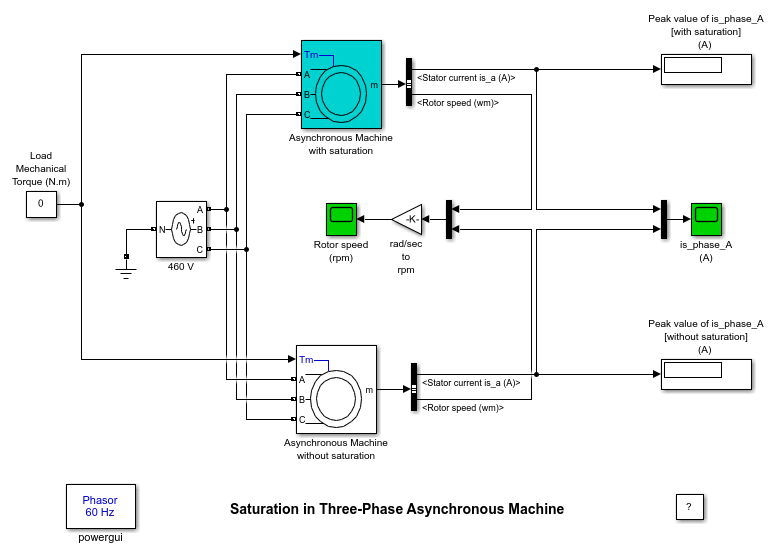Saturation in Three-Phase Asynchronous Machine
This example shows the effects of saturation in a three-phase asynchronous motor at various operating conditions.
Jean-Nicolas Paquin and Louis-A. Dessaint (Ecole de Technologie Superieure, Montreal)

Description
The model shows two identical asynchronous motors rated 50 HP, 460 V, 1800 rpm. In order to compare the linear and saturated model, saturation is implemented in the top motor only. The stator is connected to an ideal three-phase source and load torque is kept constant. Simulation is performed in phasor mode.
Simulation
1. At no load (Tm =0), (three-phase source), simulate and observe the steady-state stator current for different values of stator voltage ranging from 0.5*nominal_voltage (230 Vrms L-L) to 1.5*nominal voltage (690 Vrms L-L). For the saturated motor, you should observe that each operating point lies on the I_versus_V saturation curve specified by the Saturation Parameters. Obviously, a voltage value below the saturation voltage (first point supplied in the Saturation Parameters) will produce the same current for both motors.
Observe the impact of saturation for different torque values ranging from zero to nominal torque (197 N.m).
Note that during motor start up the 60-Hz component of current observed on the 'is_phase_A' scope model is higher for the saturated model.
2. The locked rotor test is generally used to determine the approximate values of the rotor parameters. In that specific case where the slip is unitary, the impedance of the rotor branch becomes so low that the magnetizing current is negligible compared to the rotor and stator currents. Therefore, the magnetizing branch can be neglected and it can be assumed that the saturation has no influence.
To simulate a locked rotor, specify an infinite inertia (J=inf in the machines' dialog boxes). Simulate with 460V source voltage (nominal voltage) and then 690V (1.5*nominal voltage). Observe both machines' stator currents in steady-state. You should observe stator currents for saturated and unsaturated motors, very close to each other. This shows that when the rotor of an asynchronous motor is blocked, saturation is negligible.
